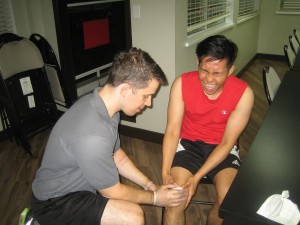Patellofemoral pain syndrome is characterized as pain at the front part of the knee joint. This occurs once the patella rubs beneath the femur bone. It is often believed that incorrect tracking or rubbing of the patella over the femur is a main factor and results to damage to the articular cartilage beneath the patella.
It is common among those who engage in sports especially among adolescent girls. There are various causes but damage to the cartilage will not directly trigger pain due to the lack of blood vessels or nerves. Nevertheless, it can lead to other issues that causes pain.
Overuse is the initial cause of patellofemoral pain syndrome. It might be due to external factors such as an abrupt increase in training or engaging in high intensity jumping and knee bending or from internal factors such as poor patella tracking.
Indications

- Aching pain in the knee joint especially at the front part of the knee around and beneath the patella
- Tenderness along the interior border of the patella
- Swelling that oftentimes arises after exercise
- The pain is often intensified when moving up and down hill or being seated for long hours
- Cracking or clicking sound when the knee is bent
- Deterioration of the quadriceps muscles if the injury is old
- Muscles around the knee joint become tight
Management
The treatment for patellofemoral pain syndrome is aimed on reducing the symptoms, identifying the causes and re-training the muscles.
- The PRICE method is used after activity to minimize the pain and swelling. The individual should take a break from any aggravating activities until pain-free.
- A knee brace or support can be used especially one that has a hole in the middle for the patella along with straps that are pulled across the knee for added support.
- A taping technique for the patella is ideal in controlling its position and alleviate the symptoms.
- The doctor might prescribe anti-inflammatory medications such as ibuprofen.
- Sports massage can help loosen up any tight structures and muscles that contributes to the symptoms
- In some cases, gait analysis is done to figure out if the individual overpronates and orthotic inserts can correct poor foot biomechanics.
- In severe cases, the doctor will recommend surgery that involves releasing the tight lateral knee structures but there is limited proof to its success.
